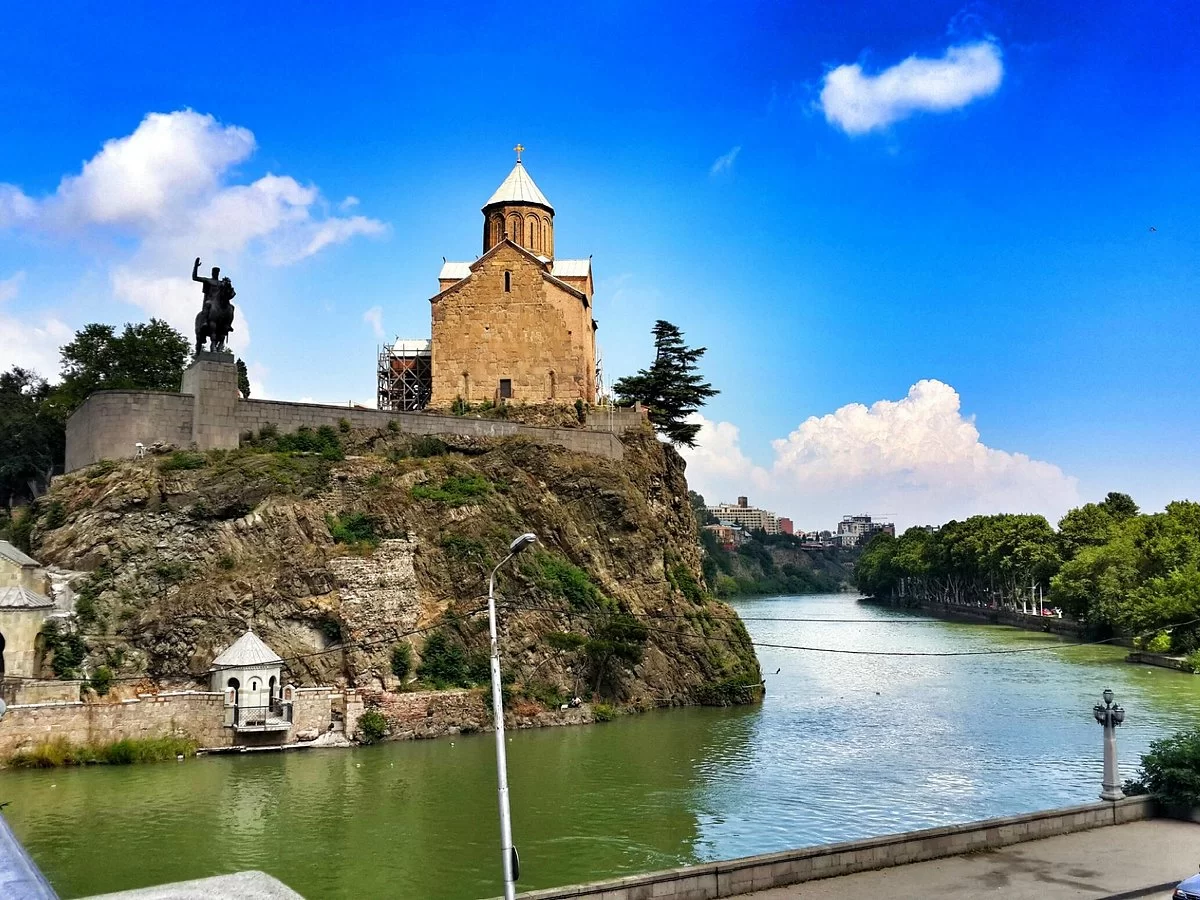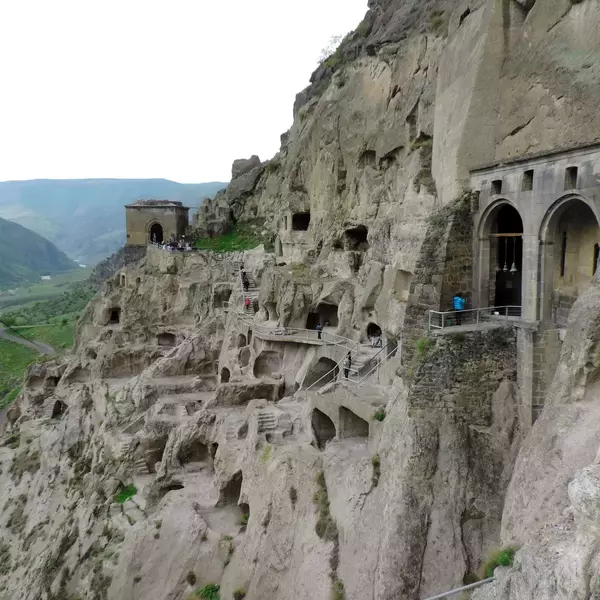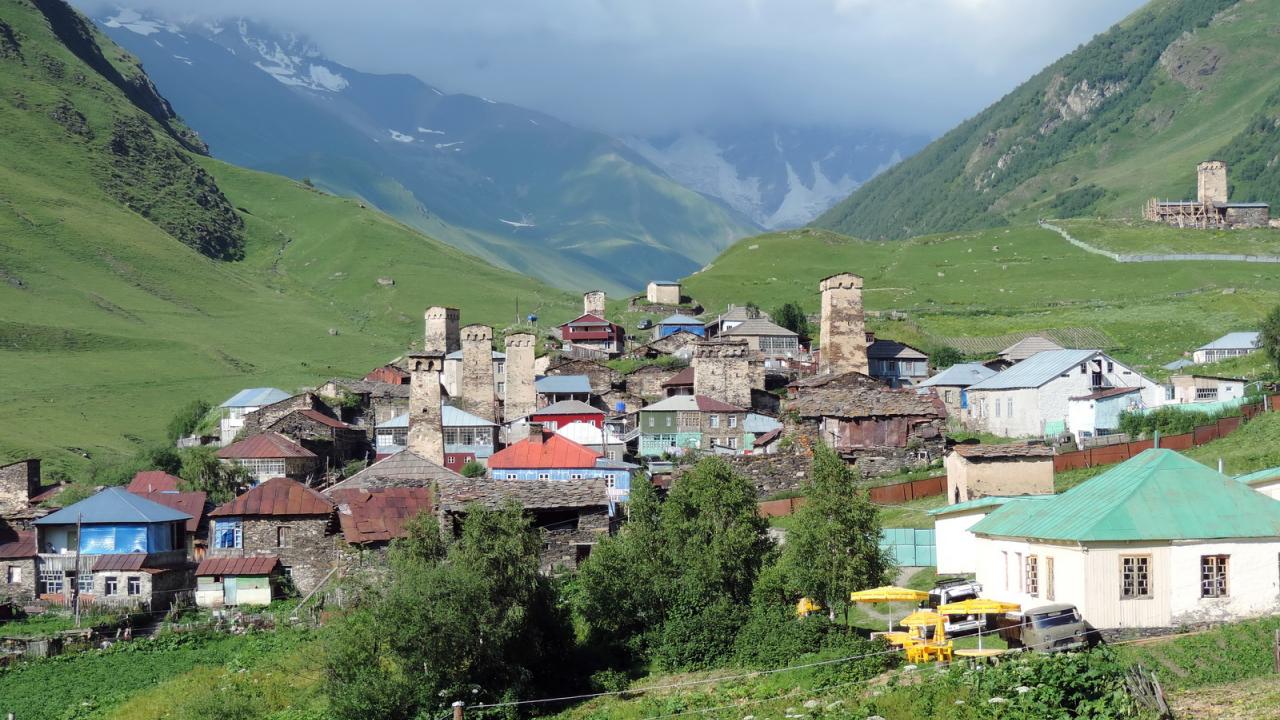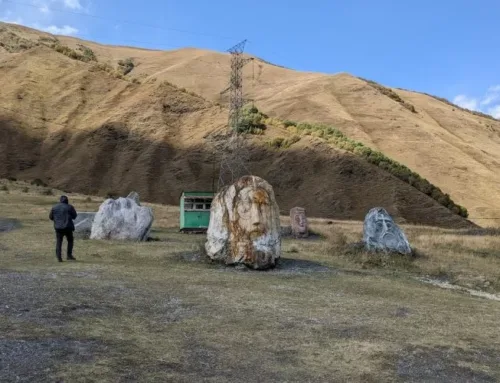Svetitskhoveli

Mtskheta had been the capital of the East Georgian Kingdom of Kartli from III c. BC till the end of V c. AD. Following the removal of the capital to Tbilisi that took place in the reign of King Vakhtang Gorgasali, Mtskheta has remained the spiritual center of the country with the residence-cathedral of the head of Georgian Orthodox Church – Catholicos-Patriarch of Georgia located there. The very beginning of Georgian Christian architecture is related to this city. The first church was built by the convertor of Georgians – st. Nino, strongly supported by the ruler of Kartli – King Mirian was erected in Mtskheta. The legend claims that this first church was built on the plot, where the part of the holly tunic of Christ was buried, brought by Elioz – a Mtskheta Jew. Just in this place a miracle-working, myrrh issuing and healing holly tree has bloomed, later named Sveti Tskhoveli – “Living pillar”.
A large three-navy basilica with arches in the interior resting on cross-shaped columns was constructed here in the reign of King Vakhtang Gorgasali. The construction had an extended apse with faceted exterior and lateral chapels (remains of the basilica together with its layout were revealed during archaeological excavations of the area conducted in 1960-70-ies and in 2006). Apparently, in the course of time this earlier building suffered heavy damages and at the beginning of XI c. a domed temple was erected instead that still stands there, although considerably reconstructed. Catolicos-Patriarch of Georgia Melkisedek initiated the construction.
History has saved the name of an architect of the temple – Arsukidze. According to the architects’ decision, rather large sections of longitudinal walls of the initial basilica of Gorgasali times were incorporated into the new structure (first of all within the western section), coupled with column feet adorned with fretwork and sculptures of bullheads fixed on the external facing of the Sanctuary. The new temple basically collides with the layout of the previous basilica, only the sanctuary is added. In fact, Arsukidze’s temple is a recorded cross-type building with a long three-nave western arm. A gallery was arranged above the lateral sections of the western arm and internal narthex. It seems that for the purposes of optical convergence of the dome and the sanctuary the western arm is widened eastwards. The whole of the space, enveloped by the structure built of neatly hewn stones is directed forward and tends to the heavens. it has the respective and compatible external settings – facades are split by rod arcades, window frames and triangular niches in the eastern wall etc. At least western and eastern fronton edges were adorned with risings. The same type of decoration is missing on the eastern front – seemingly it is lost forever, while the western one is decorated with the image of Christ on the Throne surrounded by the host of Angels. Current reliefs of different sizes scattered on almost every section of the temple walls indicate that initially its exterior was sumptuously adorned with sculptured decoration.
Both the interior and exterior of the temple sanctuary best reveal the initial features of Arsukidze’s creation – the whole solemnity, scale, and monumentality of the XI-century cathedral can fully and comprehensively be experienced while looking at the particular part of the gorgeous construction. Svetitskhoveli cathedral of the Twelve disciples was adorned with wall paintings shortly after the completion of its construction. Only tiny fragments of the original wall painting have survived till now. Even the sanctuary wall painting, with most parts devoted to the fresco of “Christ in full glory” with the enormous figure of Christ, was re-painted at the end of XIX c.
The temple suffered significant damages in the turn of XIV-XV cc, when during the invasion of Tamerlan – the dome with the barrel, western supporting columns, and arches were destroyed. Following the restoration of peace and order in the country, during the reign of Alexander the Great Svetitskhoveli temple was restored. The restored temple differed from the original to some extent. For instant: galleries were never rebuilt, and neither was the closing rib of the western arm – twice as wide new arch has been constructed instead. Many other innovations occurred on facades, the western entrance was totally newly faced, etc. In later times, following the order and will of king Rostom of Kartli and queen Mariam – the dome of the temple was renewed. Finally, all chapels arranged along the longitudinal walls of the temple were demolished.
Some fragments of XVI-XVII cc wall painting are preserved in the interior of the temple. The painting of a small arch of the “Living pillar” erected inside the building is of XVII c. with scenes narrated in Gospels and several basic moments related to the enlightenment of Kartli. Paintings were performed by an artist Grigol Gularjishvili, commissioned by Patriarch Nikolas.
The floor of the temple is covered with many tombs, the majority of which have historical significance – Kings Vakhtang Gorgasali, Erekle II, and Giorgi XII are buried here with the gravestones renewed in 1960-ies. Martyr of VI c. St. Evstati, king of Georgia Demetre II, and many other statesmen were honored to find here the last refuge.
The current defensive wall around Svetitskhoveli was constructed in XVIII c, with remains of the residence of Patriarch Melkisedek of the first half of XI c incorporated into it. The two-storied main entrance built (or faced) by this highest clerical, with so-called “Solemn arch” on the ground floor and a triple arcade on the first has also been incorporated into the fortification.
We always visit Svetitskhoveli cathedral during our tour in Mtskheta.


















